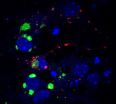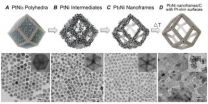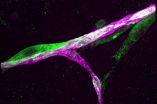(Press-News.org) In 2007, in an article published in Nature Neuroscience, scientists at the Institute for Research in Biomedicine (IRB Barcelona) headed by Joan Guinovart, an authority on glycogen metabolism, reported that in Lafora Disease (LD), a rare and fatal neurodegenerative condition that affects adolescents, neurons die as a result of the accumulation of glycogen—chains of glucose. They went on to propose that this accumulation is the root cause of this disease.
The breakthrough of this paper was two-sided: first, the researchers established a possible cause of LD and therefore were able to point to a plausible therapeutic target, and second, they discovered that neurons have the capacity to store glycogen—an observation that had never been made—and that this accumulation was toxic.
Some scientists sceptical about the article upheld that the glycogen deposits were not cause by the neurodegeneration but were a consequence of another, more important, cell imbalance, such as a down deregulation of autophagy—the cell recycling and cleaning programme. In several articles, Guinovart's "Metabolic engineering and diabetes therapy" group has recently brought to light evidence of the toxicity of glycogen deposits for LD patients, and has now provided irrefutable data.
In an article published at the beginning of February in Human Molecular Genetics, with the associate researcher Jordi Duran as first author, the scientists show that in LD the accumulation of glycogen directly causes neuronal death and triggers cell imbalances such a decrease in autophagy and synaptic failure. All these alterations lead to the symptoms of LD, such as epilepsy.
Glycogen, a Trojan horse for neurons?
There was still a greater mystery to be solved. Was glycogen synthase truly a Trojan horse for neurons, as apparently established in the article in Nature Neuroscience? That is to say, was the accumulation of glycogen always fatal for cells, thus explaining why their glycogen synthesis machinery is silenced? The inevitable question was then why these cells had such machinery.
In another paper published in Journal of Cerebral Blood Flow & Metabolism, part of the Nature Group, the researchers provided the first evidence that neurons constantly store glycogen but in a different way: accumulating small amounts and using it as quickly as it becomes available. In this regard, the scientists set up new, more sensitive, analytical techniques to confirm that the machinery responsible for glycogen synthesis and degradation existed. In summary, they showed that, in small amounts, glycogen is beneficial for neurons.
"For example, while the liver accumulates glycogen in large amounts and releases it slowly to maintain blood sugar levels, above all when we sleep, neurons synthesize and degrade small amounts of this polysaccharide continuously. They do not use it as an energy store but as a rapid and small, but constant, source of energy," explains Guinovart, also senior professor at the University of Barcelona (UB).
To observe the action of glycogen, the scientists forced cultured mouse neurons to survive under oxygen depletion. They demonstrated that the first cells to die were those in which the capacity to synthesise glycogen had been removed. The same experiments were performed in collaboration with Marco Milán's "Development and growth control" group in the in vivo model of the fruit fly Drosophila melanogaster. These tests led to the same conclusions.
The researchers postulated that glycogen is a lifeguard under oxygen depletion, a condition that leads the brains to shut down and that often occurs at birth and in cerebral infarctions in adults, which leads to severe consequences, such a cerebral paralysis.
"It is the first function of glycogen that we have discovered in neurons, but we still have to identify its function in normal conditions and establish how the mechanism works," says Jordi Duran. Postdoctoral researcher Isabel Saez is the first author of the article out today, which involved the collaboration of ICREA Research Professor Marco Milán's lab.
The beneficial and toxic roles of brain glycogen are currently the focus of main research lines conducted by Joan Guinovart's lab.
INFORMATION:Reference articles:
Glycogen accumulation underlies neurodegeneration and autophagy impairment in Lafora disease
Jordi Duran, Agnès Gruart, Mar García-Rocha, José M. Delgado-García and Joan J. Guinovart
Human Molecular Genetics (2014 )1. AOP 4 february, doi:10.1093/hmg/ddu024
Neurons have an active glycogen metabolism that contributes to tolerance to hypoxia
Isabel Saez, Jordi Duran, Christopher Sinadinos, Antoni Beltran, Oscar Yanes, MaríaFlorencia Tevy,Carlos Martínez-Pons, Marco Milán and Joan J Guinovart
Journal of Cerebral Blood Flow & Metabolism (2014), advance online publication, February 26, 2014; doi:10.1038/jcbfm.2014.33
Researchers reveal the dual role of brain glycogen
An excess of glycogen causes neuronal death while a lack of this polysaccharide endangers these cells under oxygen shortage to the brain
2014-02-27
ELSE PRESS RELEASES FROM THIS DATE:
UCSB study reveals evolution at work
2014-02-27
New research by UC Santa Barbara's Kenneth S. Kosik, Harriman Professor of Neuroscience, reveals some very unique evolutionary innovations in the primate brain.
In a study published online today in the journal Neuron, Kosik and colleagues describe the role of microRNAs — so named because they contain only 22 nucleotides — in a portion of the brain called the outer subventricular zone (OSVZ). These microRNAs belong to a special category of noncoding genes, which prevent the formation of proteins.
"It's microRNAs that provide the wiring diagram, dictating which genes ...
Big step for next-generation fuel cells and electrolyzers
2014-02-27
A big step in the development of next-generation fuel cells and water-alkali electrolyzers has been achieved with the discovery of a new class of bimetallic nanocatalysts that are an order of magnitude higher in activity than the target set by the U.S. Department of Energy (DOE) for 2017. The new catalysts, hollow polyhedral nanoframes of platinum and nickel, feature a three-dimensional catalytic surface activity that makes them significantly more efficient and far less expensive than the best platinum catalysts used in today's fuel cells and alkaline electrolyzers. This ...
Fossilized human feces from 14th century contain antibiotic resistance genes
2014-02-27
A team of French investigators has discovered viruses containing genes for antibiotic resistance in a fossilized fecal sample from 14th century Belgium, long before antibiotics were used in medicine. They publish their findings ahead of print in the journal Applied and Environmental Microbiology.
"This is the first paper to analyze an ancient DNA viral metagenome," says Rebecca Vega Thurber of Oregon State University, Corvallis, who was not involved in the research.
The viruses in the fecal sample are phages, which are viruses that infect bacteria, rather than infecting ...
Physicians' stethoscopes more contaminated than palms of their hands
2014-02-27
VIDEO:
A comparative analysis shows that stethoscope diaphragms are more contaminated than the physician's own thenar eminence (group of muscles in the palm of the hand) following a physical examination.
Click here for more information.
Rochester, MN, February 27, 2014 – Although healthcare workers' hands are the main source of bacterial transmission in hospitals, physicians' stethoscopes appear to play a role. To explore this question, investigators at the University of ...
Study reveals mechanisms cancer cells use to establish metastatic brain tumors
2014-02-27
NEW YORK, NY, February 27, 2014 — New research from Memorial Sloan Kettering provides fresh insight into the biologic mechanisms that individual cancer cells use to metastasize to the brain. Published in the February 27 issue of Cell, the study found that tumor cells that reach the brain — and successfully grow into new tumors — hug capillaries and express specific proteins that overcome the brain's natural defense against metastatic invasion.
Metastasis, the process that allows some cancer cells to break off from their tumor of origin and take root in a different tissue, ...
Methane leaks from palm oil wastewater are a climate concern, CU-Boulder study says
2014-02-27
In recent years, palm oil production has come under fire from environmentalists concerned about the deforestation of land in the tropics to make way for new palm plantations. Now there is a new reason to be concerned about palm oil's environmental impact, according to researchers at the University of Colorado Boulder.
An analysis published Feb. 26 in the journal Nature Climate Change shows that the wastewater produced during the processing of palm oil is a significant source of heat-trapping methane in the atmosphere. But the researchers also present a possible solution: ...
Famed Milwaukee County Zoo orangutan's death caused by strange infection
2014-02-27
MADISON – Mahal, the young orangutan who became a star of the Milwaukee County Zoo and an emblem of survival for a dwindling species, led an extraordinary life.
It turns out, the young ape died an extraordinary death, too.
Rejected by his biological mother at the Cheyenne Mountain Zoo in Colorado Springs, Colo., and eventually flown to Milwaukee aboard a private jet to live with a surrogate mother, Mahal became one of the Milwaukee County Zoo's star attractions. His unexpected death at age 5 in late December 2012 was a shock to the community that came to know him through ...
Scientists describe deadly immune 'storm' caused by emergent flu infections
2014-02-27
LA JOLLA, CA—February 26, 2014—Scientists at The Scripps Research Institute (TSRI) have mapped key elements of a severe immune overreaction—a "cytokine storm"—that can both sicken and kill patients who are infected with certain strains of flu virus.
Their findings, published in this week's online Early Edition of the Proceedings of the National Academy of Sciences, also clarify the workings of a potent new class of anti-inflammatory compounds that prevent this immune overreaction in animal models.
"We show that with this type of drug, we can quiet the storm enough to ...
Livestock found ganging up on pandas at the bamboo buffet
2014-02-27
VIDEO:
A panda in the Wolong Nature Reserve munches on bamboo -- which comprises 99 percent of the endangered species' diet in the wild.
Click here for more information.
Pandas, it turns out, aren't celebrating the Year of the Horse.
Livestock, particularly horses, have been identified as a significant threat to panda survival. The reason: They're beating the pandas to the bamboo buffet. A paper by Michigan State University panda habitat experts published in this week's Journal ...
Making treatment of rare blood disorder more affordable and effective
2014-02-27
PHILADELPHIA — A University of Pennsylvania research team has defined a possible new way to fight a disease that is currently treatable only with the most expensive drug available for sale in the United States. In a study published this month in Blood, the Penn team describes the strategy, based on the oldest part of the human immune system – called "complement" -- that could turn out to be less costly and more effective for the majority of patients with a rare blood disorder.
Complement is a network of more than 50 proteins in the blood and on cell surfaces that quietly ...
LAST 30 PRESS RELEASES:
Jeonbuk National University researchers explore the impact of different seasonings on the flavor perception of Doenjang soup
Two Keck Medicine of USC Hospitals named Leapfrog Top Teaching Hospitals
World-first discovery uncovers how glioblastoma tumours dodge chemotherapy, potentially opening the door to new treatments
A fatal mix-up: How certain gut bacteria drive multiple sclerosis
New AI tool identifies not just genetic mutations, but the diseases they may cause
Deep-learning model predicts how fruit flies form, cell by cell
Combination pills for high blood pressure may simplify treatment, improve long-term health
Immune system keeps mucosal fungi in check
Neurons within the brain use simple rules to localize genetic messages
Electrodes created using light
Second-hand gift-giving is a well-deliberated decision
How human interaction drove evolution to make bears less aggressive
National Poll: Few parents offer teens guidance on healthy eating during holiday season
Cannabis derivatives could provide new ovarian cancer treatments
Raising strong yeast as a petroleum substitute
Clues to the origin of hot Jupiters hidden in their orbits
Canada’s reduced pledge to Global Fund will impact domestic health
1 in 4 children with major traumatic injuries not cared for in pediatric trauma centres
Duke and Duke-NUS’ joint cross-population research to uncover "East-West" differences in disease and care
Scientists to ‘spy’ on cancer- immune cell interactions using quantum technology breakthrough
Tech savvy users have most digital concerns
Making lighter work of calculating fluid and heat flow
Normalizing blood sugar can halve heart attack risk
Lowering blood sugar cuts heart attack risk in people with prediabetes
Study links genetic variants to risk of blinding eye disease in premature infants
Non-opioid ‘pain sponge’ therapy halts cartilage degeneration and relieves chronic pain
AI can pick up cultural values by mimicking how kids learn
China’s ecological redlines offer fast track to 30 x 30 global conservation goal
Invisible indoor threats: emerging household contaminants and their growing risks to human health
Adding antibody treatment to chemo boosts outcomes for children with rare cancer
[Press-News.org] Researchers reveal the dual role of brain glycogenAn excess of glycogen causes neuronal death while a lack of this polysaccharide endangers these cells under oxygen shortage to the brain






